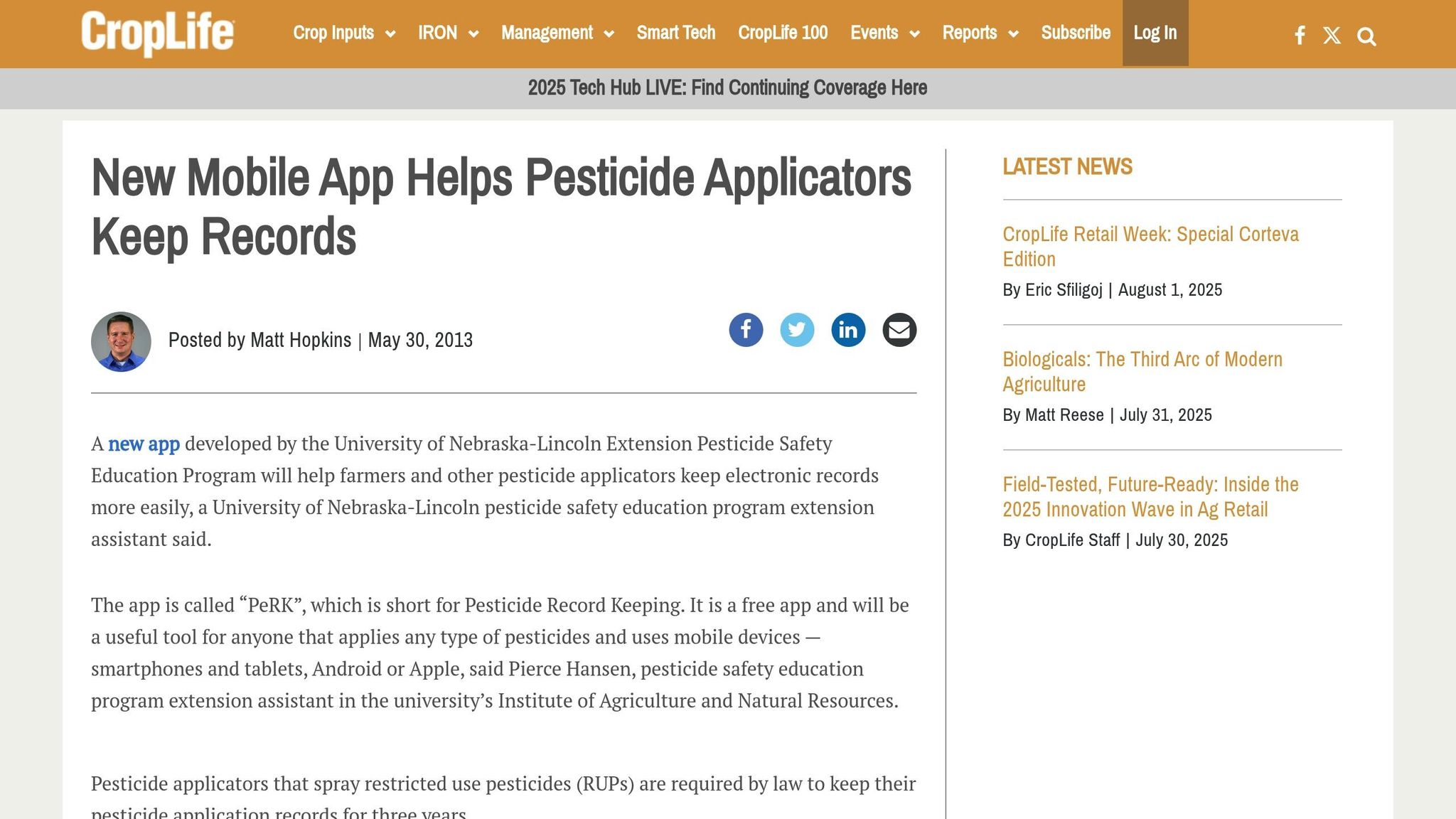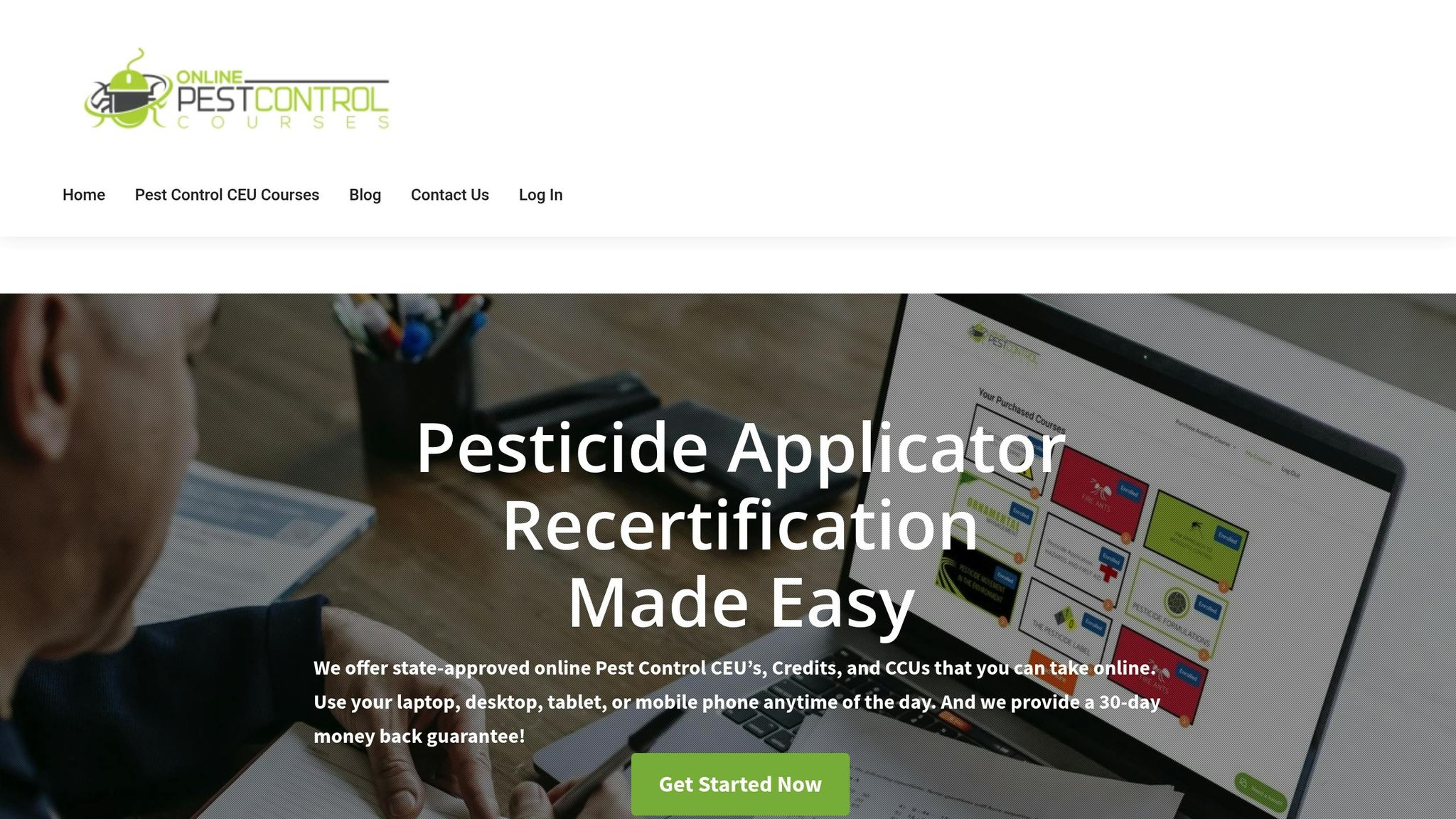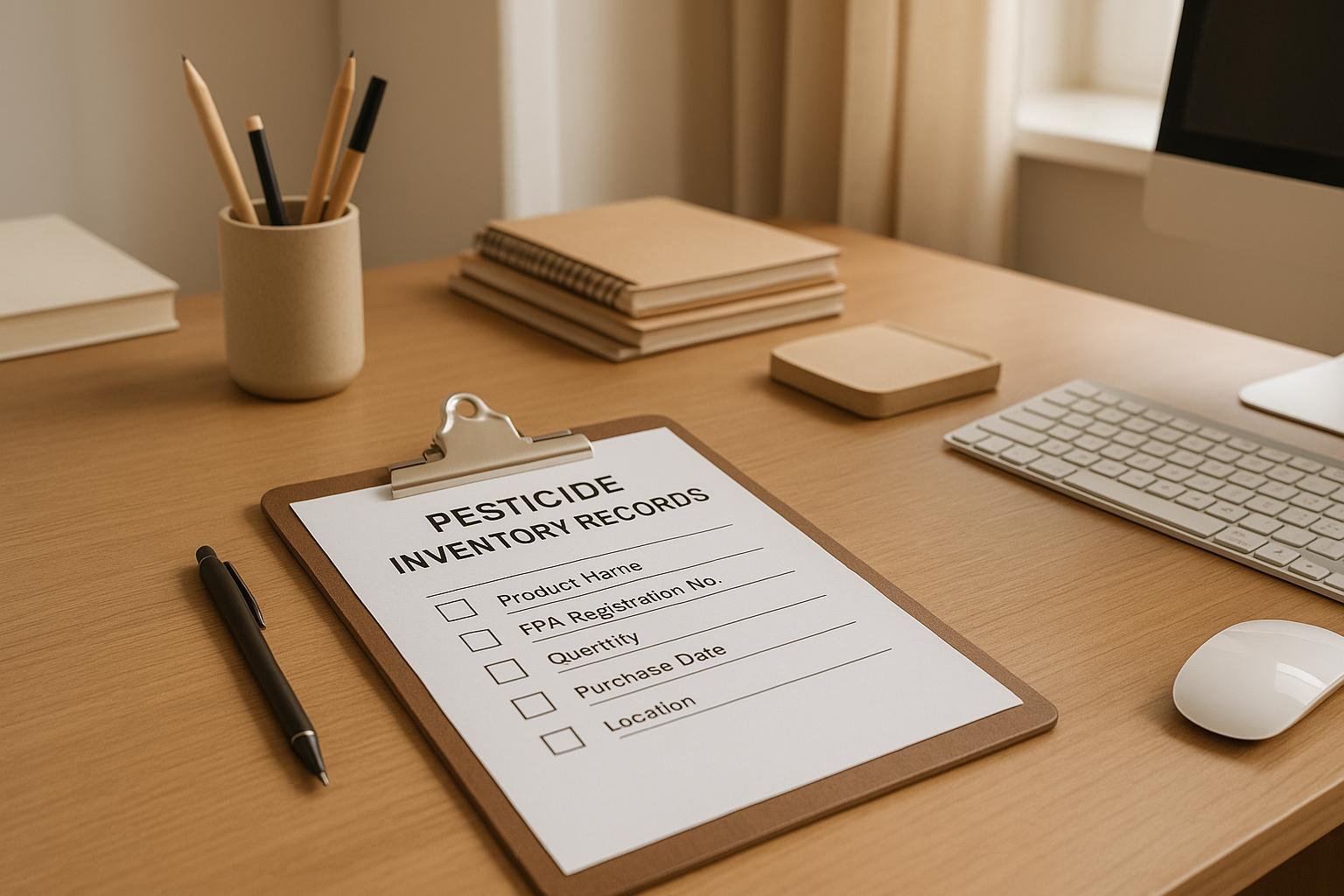Keeping accurate pesticide inventory records is not just a legal requirement – it’s also key to avoiding fines and managing your business effectively. Both federal and state laws outline specific rules for record-keeping, with states often imposing stricter regulations than federal guidelines. Here’s what you need to know:
- Federal Requirements: The EPA mandates private applicators to log restricted-use pesticide (RUP) applications within 14 days, with records retained for 2 years. Details like product name, EPA registration number, and application specifics are required.
- State-Specific Rules: Some states require records for all pesticide types (not just RUPs), longer retention periods (e.g., 3+ years), and additional data like weather conditions.
- Digital vs. Paper Records: Digital systems simplify compliance by automating tasks, offering secure storage, and enabling real-time updates. Paper records, while cheaper upfront, are more prone to damage and harder to manage at scale.
- Common Mistakes: Missing details, outdated records, and missed deadlines can lead to violations. Regular audits, immediate logging of changes, and staff training reduce these risks.
- Training: State-approved courses help applicators stay compliant with both federal and state laws, making it easier to manage records and renew licenses.
Quick Tip: Always check your state’s specific pesticide regulations, as they often exceed federal standards.
PeRK – A Pesticide Recordkeeping App

State-Specific Inventory Record Requirements
States often go beyond federal record-keeping rules, adding extra details and requiring longer retention periods. These state-specific regulations build on the federal standards and outline what’s necessary for pesticide inventory records.
Required Record Elements
Federal guidelines provide the basics for record-keeping, but many states require additional details tailored to local regulations.
For commercial applicators, the rules are often stricter. For instance, they must provide customers with a copy of all required data elements within 30 days of applying any restricted-use pesticide.
Record Retention Periods and Reporting Rules
Federal law requires pesticide application records to be kept for at least two years. However, some states extend this timeframe. For example, Texas has a detailed retention schedule that can exceed federal requirements, mandating records be kept for longer periods when specified by state law.
Reporting rules also differ by state. In California, the Department of Pesticide Regulation enforces stricter controls than the federal EPA. A notable example occurred in 2015 when chloropicrin applications were capped at 40 acres per day due to health concerns like coughing, eye irritation, and headaches. These state-specific rules highlight the importance of understanding local variations to ensure compliance.
State Requirements Comparison
Pesticide inventory record requirements vary significantly from state to state. Some states adopt stricter rules than the federal baseline, which can include unique reporting deadlines, extended retention periods, or additional documentation standards. For applicators working across state lines, it’s crucial to contact the state’s lead pesticide regulation agency – typically the department of agriculture – for guidance.
This attention to state-specific requirements not only ensures legal compliance but also enhances inventory management and strengthens business operations. Proper records support both regulatory obligations and better decision-making.
Best Practices for Compliant Inventory Management
Keeping accurate pesticide inventory records isn’t just about ticking regulatory boxes – it’s also a cornerstone of smoother operations. By setting up clear, efficient processes, you can meet state and federal requirements while streamlining your day-to-day work. Here’s how to make it happen.
Digital vs. Paper Record Systems
How you track your pesticide inventory – whether through digital tools or traditional paper methods – makes a big difference in staying compliant and efficient. Digital systems, in particular, offer some major perks when navigating the complexities of state-specific rules.
For starters, digital record systems simplify the process by automating tasks like data entry and organization, saving you time and reducing errors. These systems also ensure you include all the required details – brand names, EPA registration numbers, amounts applied, dates, locations, and applicator information – within the mandated 14-day window after each application.
Another big win for digital systems is accessibility. They let you update inventory in real time and provide secure, remote access, which is invaluable when regulators come knocking. Plus, with encrypted storage and automatic backups, digital records are far less vulnerable to disasters than paper ones, which can be easily damaged and require ever-increasing storage space.
Here’s a quick comparison of the two systems:
| Feature | Paper Records | Digital Records |
|---|---|---|
| Upfront Cost | Low | Moderate (software, devices, training) |
| Ongoing Cost | High (storage, manual labor) | Low (automation, cloud storage) |
| Accessibility | Limited to physical location | Remote access from any device |
| Data Security | Prone to physical damage | Encrypted and backed up |
| Scalability | Limited storage capacity | Handles growing data with ease |
If you’re considering switching to digital, start small. Run a pilot program to iron out any kinks, set clear deadlines, and offer tailored training sessions so everyone’s on the same page. And don’t stop there – regular audits will keep your records accurate and compliant.
Regular Audits and Accuracy Checks
Once your records are in place, regular audits are your next line of defense. Whether you do them monthly or quarterly, audits help you keep stock levels accurate, minimize waste, and stay on the right side of state regulations. During an audit, compare your physical inventory to your records, and watch for patterns that could indicate theft, overuse, or under-ordering. Don’t forget to check expiration dates on chemical labels and ensure everything is stored correctly.
It’s also a good idea to inspect your equipment during these audits. Look for wear and tear, missing parts, or damage that could affect application accuracy. Repair or retire any tools that don’t meet your standards, and safely dispose of outdated pesticides to avoid clutter and compliance risks.
To make audits even easier, consider using technologies like barcode scanners or RFID systems. These tools automatically flag discrepancies and update your inventory records in real time. Establish clear guidelines for recording pest management activities – covering frequency, level of detail, and who’s responsible – and train your team on why proper documentation matters. After all, OSHA HazCom violations are among the most common across industries.
Record Storage and Retention
Once you’ve nailed accurate record-keeping and regular audits, the next step is storing those records securely. Proper storage ensures you can quickly access records during inspections while meeting federal and state retention requirements. Federal law requires records to be kept for at least two years, but some states have longer timelines.
Digital storage is a smart choice for centralizing data. It offers role-based access, cloud backups, and protection against data loss – all while meeting extended retention needs. If you’re sticking with paper records, create an organized filing system by date, location, and pesticide type. Store these records in fireproof and waterproof containers, and keep duplicate copies in a separate location to safeguard against total loss.
Producers have additional documentation requirements, including details on production, receipts, shipments, and inventory levels. For digital systems, schedule automatic backups and test restoration processes regularly to ensure data is accessible when needed. For paper records, consider digitizing key documents to add an extra layer of protection.
Lastly, enforce strict access controls for both digital and paper records. Track who accesses the records and when to create an audit trail. This not only helps you manage sensitive pesticide information responsibly but also proves valuable during regulatory inspections.
Common Compliance Mistakes to Avoid
Keeping accurate pesticide records is essential – not just for staying compliant with regulations, but also for managing your inventory effectively. Yet, even the most organized systems can fall short if common mistakes creep in. Let’s look at a few pitfalls that can lead to fines, disruptions, or operational headaches – and how to avoid them.
Incomplete or Outdated Records
Missing details in your records, such as EPA registration numbers, application amounts, or certification data, can quickly lead to violations. Even small oversights – like forgetting to log wind direction or neglecting to update digital inventory records – can snowball into bigger issues. These gaps can throw your documented records out of sync with actual usage.
Federal regulations require private applicators to record specific details for restricted-use pesticide applications, including the product name, EPA registration number, amount applied, date, location, crop or site treated, total area covered, and applicator information. Some states, like Washington, take it a step further, requiring additional data such as wind direction, velocity, and concentration levels, with records retained for at least seven years.
Outdated records can also cause trouble. If your inventory doesn’t match actual stock, you risk running out of essential products during busy seasons or over-ordering chemicals that might expire before use. Not only does this waste money, but disposing of expired pesticides can be a logistical nightmare.
To avoid these problems, make it a habit to log inventory changes immediately – not at the end of the day or week. Set up your system to include all required details from the start. Conduct monthly inventory checks to compare recorded levels with actual stock, and investigate any discrepancies right away. This proactive approach can help you catch issues like theft, waste, or simple recording errors before they escalate.
On top of maintaining accurate records, keeping up with deadlines and regulatory changes is just as critical.
Missed Deadlines and Regulatory Changes
Failing to meet reporting deadlines or adapt to new rules can lead to fines, license suspensions, or even enforcement actions. The challenge lies in managing multiple layers of regulations. While federal law requires a two-year minimum for record retention, states often add their own requirements. Some mandate quarterly reports, others ask for annual summaries, and a few even require real-time electronic submissions for specific applications.
To stay ahead, use automated reminders and assign a team member to monitor regulatory updates. Many pest control software platforms come with calendar features that can alert you about upcoming deadlines or license renewals. Set these reminders to go off at least two weeks in advance.
It’s also a good idea to subscribe to updates from your state’s department of agriculture and join professional associations that track regulatory changes. Federal pesticide recordkeeping requirements are outlined in the Code of Federal Regulations Title 7 Part 110, but state-specific rules are often published in agricultural department bulletins.
Create a compliance calendar to track all your obligations throughout the year, including reporting deadlines, license renewals, training sessions, and equipment inspections. Review and update it regularly, especially when new regulations are announced.
Finally, ensuring your staff is well-trained in record-keeping practices is a key step in maintaining compliance.
Staff Training on Record-Keeping
Even the best systems can fail if your team isn’t properly trained. When employees don’t understand the importance of accurate documentation or how to fill out required forms, mistakes are bound to happen. That’s why ongoing, thorough training is essential.
Effective training programs should cover both the technical aspects of record-keeping and the reasons behind each requirement. Employees need to know what information to record and why it matters – for both compliance and daily operations. Training should include an overview of federal and state laws governing pesticide use, as well as step-by-step guidance on how to use your record-keeping systems.
Tailor training to specific roles within your team. For example, applicators need detailed instruction on field documentation, while inventory managers should focus on stock tracking and disposal procedures.
"Well-trained technicians support effective pest control by using tools correctly, maintaining sanitation standards, and reducing downtime caused by broken or lost equipment."
Hands-on learning combined with classroom instruction works best. Use real-life examples from your operation, practice filling out actual forms, and walk through your digital systems step by step. Incorporating tools like virtual simulations or mobile apps can make training sessions more interactive and engaging.
Schedule annual refresher courses for all staff, and hold additional sessions when regulations change or new employees join your team. Keep detailed records of all training activities, including who attended and what was covered. These records can be invaluable during regulatory inspections, serving as proof of your commitment to compliance.
sbb-itb-c4006de
State-Approved Training for Pesticide Applicators
Getting trained as a pesticide applicator isn’t just about passing a test or earning a license – it’s about gaining the knowledge and skills needed to confidently handle the complexities of pesticide record-keeping. State-approved training programs are designed to help applicators understand federal regulations and state-specific rules that govern pesticide use and inventory management. Programs like those offered by Online Pest Control Courses ensure that your practices align with both federal and state standards, giving you a solid foundation for compliance.
Online Pest Control Courses Overview

State-approved online courses provide a modern, flexible way to master the intricacies of record-keeping and compliance. These programs are designed to fit into your schedule, offering on-demand access to certification materials and instant certificate downloads. Online Pest Control Courses, for example, cover a range of essential topics, including pesticide laws, digital record-keeping, and best practices for safe and compliant pesticide management.
The platform provides state-approved CEUs, CCUs, and credits, which can be accessed on any device. This means you can complete training modules during downtime at work or from the comfort of your office. The courses are not only convenient but also comprehensive, covering everything from pesticide formulations and environmental considerations to pest management strategies. This practical approach ensures you’re not just learning regulations – you’re also gaining the tools to apply them effectively in your day-to-day operations.
For many applicators, continuing education units (CEUs) are a requirement for license renewal. Online courses eliminate the logistical challenges of attending in-person sessions, offering a mobile-friendly solution that works around your schedule. These programs also reinforce all the key record-keeping details you need to stay fully compliant with state and federal laws.
How Training Supports Compliance
Continuing education goes beyond meeting licensing requirements – it equips you with the knowledge to navigate the often complicated landscape of federal and state regulations. For instance, federal law requires certified applicators to maintain records for at least two years. However, state regulations often add extra layers of detail. Training helps clarify these overlapping requirements, ensuring you don’t miss critical documentation steps.
"Proper training is essential to running a successful pest control business. It ensures your team is knowledgeable, compliant, and prepared to deliver high-quality pest control services." – David Bailey
Training programs also address the technical challenges of record-keeping. You’ll learn how to document spot treatments, manage restricted-entry intervals (REIs), and handle application exclusion zones (AEZs) – all areas where state-specific rules often come into play. Without proper training, even experienced applicators can overlook these details, leading to potential compliance issues.
Beyond compliance, training introduces you to digital record-keeping systems that enhance accuracy and accessibility. As more pest control businesses transition away from paper-based systems, these courses teach you how to use technology for better inventory management while still meeting regulatory requirements.
The pest control industry is constantly evolving. Regulations change, customer expectations shift, and new management techniques emerge. Training programs keep you informed about updates, helping you adapt your practices before new rules take effect. This proactive approach not only helps you avoid compliance issues but also ensures your operations run smoothly. By integrating updated practices into your daily workflow, you maintain compliance while improving efficiency.
Key Takeaways
State Requirements Summary
Keeping accurate records for pesticide applications isn’t just a good practice – it’s a legal obligation that safeguards your business. Federal law mandates certified applicators to keep records of restricted-use pesticides for at least two years, but many states take it further. For instance, New York and Pennsylvania require records to be retained for three years, while Delaware adds a twist by mandating detailed weather conditions for every application.
These differences highlight the importance of knowing your state’s specific rules. Non-compliance can be costly, with civil penalties reaching up to $750 for a first offense and at least $1,100 for subsequent violations. Beyond avoiding fines, thorough records are invaluable for tracking inventory, assessing how well applications work, and protecting your business in case of an investigation. Errors or omissions in your records can breach both state and federal laws. Use this information as a starting point to ensure your record-keeping practices are both effective and compliant.
Final Compliance Recommendations
To stay on top of your record-keeping obligations, consider these practical steps. Assign one person to oversee pesticide records and ensure updates are made daily. Whether you prefer a paper-based or digital system, consistency is what matters most.
Perform regular audits to catch any mistakes or omissions early. Daily updates paired with monthly reviews help ensure your records include all required details – such as application dates, EPA registration numbers, dosage rates, target pests, and even weather conditions when necessary.
"If you use pesticides in your operation, you must comply with the necessary record keeping… Good record keeping on pesticide application may save you valuable time and money." – Linda Falcone, Extension Educator, Pennsylvania State University
Training your staff is another critical piece of the puzzle. Everyone involved in pesticide applications should be well-versed in your state’s specific documentation requirements. Platforms like Online Pest Control Courses offer state-approved training that not only covers these regulations but also helps employees earn continuing education credits to stay up-to-date.
Lastly, keep an eye on regulatory changes. Pesticide laws can shift, and what was acceptable last year might not meet today’s standards. Use resources like state extension services and approved training programs to stay informed. Accurate records aren’t just about avoiding penalties – they’re essential tools for making smart pest management decisions and safeguarding your business’s reputation.
FAQs
What are the advantages of using digital tools for pesticide inventory record-keeping instead of paper-based methods?
Switching to digital tools for managing pesticide inventory brings clear benefits compared to old-fashioned paper methods. For starters, digital systems make it easier to track inventory in real time, cutting down on time spent manually updating records and simplifying reporting tasks. This not only saves time but also helps reduce mistakes that can occur with manual entries, ensuring records are accurate and aligned with state regulations.
Another advantage is the improved data security these platforms offer. They also allow quick access to historical records, which can be a lifesaver during audits or inspections. Plus, by reducing waste and improving precision, digital tools support smarter, more efficient pest management while helping to save money in the long run.
How can I comply with federal and state pesticide record-keeping laws if I work in multiple states?
To meet federal and state pesticide record-keeping laws, it’s crucial to keep detailed records of all restricted-use pesticide (RUP) applications as mandated by federal law. These records should include key information like the date of application, location, pesticide name, and the amount used. Additionally, you’re required to retain these records for at least two years.
State laws can be stricter and often require tracking all pesticide applications, not just RUPs. Some states might also mandate extra documentation or longer record retention periods. Staying informed about the specific rules in each state you operate in is essential to remain compliant.
For a smoother compliance process, consider signing up for state-approved online training courses designed for pesticide applicators. These courses provide updates on regulatory changes and help ensure you’re consistently meeting both federal and state requirements.
What are the most common pesticide inventory record-keeping mistakes, and how can I avoid them to stay compliant?
Common Mistakes in Pesticide Inventory Record-Keeping
One of the biggest challenges in pesticide inventory management comes from incomplete or inaccurate records, failing to update them consistently, and poorly organizing storage and usage data. These mistakes can create compliance headaches and make managing your inventory far less efficient.
To steer clear of these problems, make sure to document every pesticide application in detail. This includes recording the product name, quantity used, date of application, and location. Keep your records structured and easy to access, and make it a routine to review and update them regularly to match your current inventory. Digital tools or dedicated software can be a game-changer here, reducing manual errors while helping you meet state compliance standards.
If you’re looking for extra support, consider signing up for state-approved online training. These programs can keep you updated on pesticide regulations and teach best practices for maintaining accurate records.







